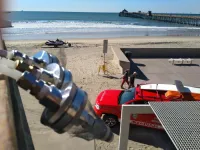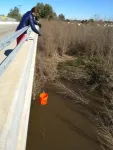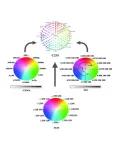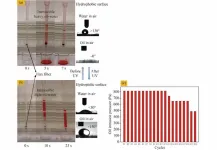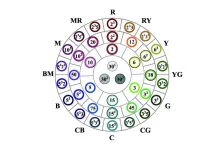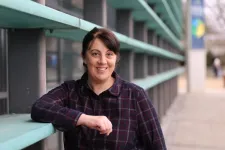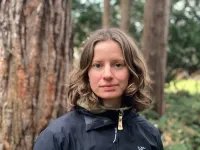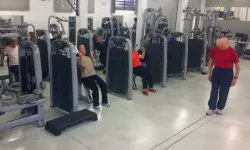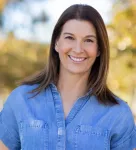(Press-News.org) New research led by Scripps Institution of Oceanography at UC San Diego has confirmed that coastal water pollution transfers to the atmosphere in sea spray aerosol, which can reach people beyond just beachgoers, surfers, and swimmers.
Rainfall in the US-Mexico border region causes complications for wastewater treatment and results in untreated sewage being diverted into the Tijuana River and flowing into the ocean in south Imperial Beach. This input of contaminated water has caused chronic coastal water pollution in Imperial Beach for decades. New research shows that sewage-polluted coastal waters transfer to the atmosphere in sea spray aerosol formed by breaking waves and bursting bubbles. Sea spray aerosol contains bacteria, viruses, and chemical compounds from the seawater.
The researchers report their findings March 2 in the journal Environmental Science & Technology. The study appears in the midst of a winter in which an estimated 13 billion gallons of sewage-polluted waters have entered the ocean via the Tijuana River, according to lead researcher Kim Prather, a Distinguished Chair in Atmospheric Chemistry, and Distinguished Professor at Scripps Oceanography and UC San Diego’s Department of Chemistry and Biochemistry. She also serves as the founding director of the NSF Center for Aerosol Impacts on Chemistry of the Environment (CAICE).
“We’ve shown that up to three-quarters of the bacteria that you breathe in at Imperial Beach are coming from aerosolization of raw sewage in the surf zone,” said Prather. “Coastal water pollution has been traditionally considered just a waterborne problem. People worry about swimming and surfing in it but not about breathing it in, even though the aerosols can travel long distances and expose many more people than those just at the beach or in the water.”
The team sampled coastal aerosols at Imperial Beach and water from the Tijuana River between January and May 2019. Then they used DNA sequencing and mass spectrometry to link bacteria and chemical compounds in coastal aerosol back to the sewage-polluted Tijuana River flowing into coastal waters. Aerosols from the ocean were found to contain bacteria and chemicals originating from the Tijuana River. Now the team is conducting follow-up research attempting to detect viruses and other airborne pathogens.
Prather and colleagues caution that the work does not mean people are getting sick from sewage in sea spray aerosol. Most bacteria and viruses are harmless and the presence of bacteria in sea spray aerosol does not automatically mean that microbes – pathogenic or otherwise – become airborne. Infectivity, exposure levels, and other factors that determine risk need further investigation, the authors said.
This study involved a collaboration among three different research groups - led by Prather in collaboration with UC San Diego School of Medicine and Jacobs School of Engineering researcher Rob Knight, and Pieter Dorrestein of the UC San Diego Skaggs School of Pharmacy and Pharmaceutical Science, both affiliated with the Department of Pediatrics - to study the potential links between bacteria and chemicals in sea spray aerosol with sewage in the Tijuana River.
“This research demonstrates that coastal communities are exposed to coastal water pollution even without entering polluted waters,” said lead author Matthew Pendergraft, a recent graduate from Scripps Oceanography who obtained his PhD under the guidance of Prather. “More research is necessary to determine the level of risk posed to the public by aerosolized coastal water pollution. These findings provide further justification for prioritizing cleaning up coastal waters.”
Additional funding to further investigate the conditions that lead to aerosolization of pollutants and pathogens, how far they travel, and potential public health ramifications has been secured by Congressman Scott Peters (CA-50) in the Fiscal Year (FY) 2023 Omnibus spending bill.
Besides Prather, Pendergraft, Knight and Dorrestein, the research team included Daniel Petras and Clare Morris from Scripps Oceanography; Pedro Beldá-Ferre, MacKenzie Bryant, Tara Schwartz, Gail Ackermann, and Greg Humphrey from the UC San Diego School of Medicine; Brock Mitts from UC San Diego’s Department of Chemistry and Biochemistry; Allegra Aron from the UC San Diego Skaggs School of Pharmacy and Pharmaceutical Science; and independent researcher Ethan Kaandorp. The study was funded by UC San Diego’s Understanding and Protecting the Planet (UPP) initiative and the German Research Foundation.
END
Coastal water pollution transfers to the air in sea spray aerosol and reaches people on land
Scientists find bacteria, chemical compounds from coastal water pollution in sea spray aerosol along Imperial Beach
2023-03-02
ELSE PRESS RELEASES FROM THIS DATE:
A bridge between hydrophobicity and hydrophilicity of flax fiber: A breakthrough in the multipurpose oil-water separation field
2023-03-02
The large number of oily wastewater discharges and oil spills are bringing about severe threats to environment and human health. Corresponding to this challenge, a number of functional materials have been developed and applied in oil-water separation as oil barriers or oil sorbents. These materials can be divided into two main categories which are artificial and natural.
Natural materials such as green bio-materials are generally low cost and abundant with biological degradability, which are also regarded as promising alternatives for oil-water separation ...
CityU scholars unify color systems using prime numbers
2023-03-02
Existing colour systems, such as RGB and CYMK, are all text-based and require a large range of values to represent different colours, making them difficult to compute and time-consuming to convert. Recently, researchers from City University of Hong Kong (CityU) made a breakthrough by inventing an innovative colour system, called “C235”, based on prime numbers, enabling efficient encoding and effective colour compression. It can unify existing colour systems and has the potential to be applied in various applications, like designing an energy-saving LCD system and colourizing DNA codons.
Currently, ...
UCD Archaeologist receives prestigious Dan David Prize for research on the invisible workforce behind ancient forms of art
2023-03-02
The Dan David Prize, the largest history prize in the world, has announced University College Dublin (UCD) Archaeologist, Dr Anita Radini, as one of nine recipients for 2023.
Each of the winners - who work in Kenya, Denmark, Israel, Canada, the US and Ireland - will receive $300,000 (USD) in recognition of their achievements as emerging scholars and to support their future endeavours in the study of the human past. Dr Radini is the first in Ireland to receive this award.
“Our winners represent the next generation of historians,” said Ariel ...
Putting a price tag on the amenity value of private forests
2023-03-02
When it comes to venturing into and enjoying nature, forests are the people’s top choice – at least in Denmark. This is also reflected in the sales prices of properties with private forest. But beyond earnings potential, this first study of its kind, conducted by the University of Copenhagen, puts a price tag on the so-called amenity value of Danish private forests.
Forests have a nearly therapeutic effect on humans. Perhaps that is why eight out of ten of Danes have wandered in the woods over ...
The map to human and animal behavior
2023-03-02
What are humans? What are animals? And what makes humans unique? The comparative psychologist Fumihiro Kano has set himself a life goal to answer those questions. On 28 February 2023 it was announced that the scientist from the Cluster of Excellence “Centre for the Advanced Study of Collective Behaviour” (CASCB) at the University of Konstanz will receive the Manfred Fuchs Prize from the Heidelberg Academy of Sciences and Humanities of the State Baden-Württemberg for his interdisciplinary work in animal behaviour research.
Photo gallery for the article: https://www.campus.uni-konstanz.de/en/science/the-map-to-human-behaviour
Fumihiro ...
Resistance training improves sleep quality and reduces inflammation in older people with sarcopenia
2023-03-02
Sarcopenia is the decline of skeletal muscle mass with age, leading to loss of muscle strength (to move objects, shake hands etc.) and performance (walking and making other routine movements effectively). It involves chronic inflammation and is associated with cognitive alterations, heart disease and respiratory disorders. In short, it affects the quality of life, reducing independence and increasing the risk of injury, falls and even death.
Sarcopenia affects 15% of adults over the age of 60 and 46% of those over 80. Sleep disorders are also common in these age groups. The aging ...
Bald eagles aren’t fledging as many chicks due to avian influenza
2023-03-02
Bald eagles are often touted as a massive conservation success story due to their rebound from near extinction in the 1960s.
But now a highly infectious virus may put that hard-fought comeback in jeopardy.
Published in Nature’s Scientific Reports, new research from the University of Georgia showed highly pathogenic avian influenza, also known as H5N1, is killing off unprecedented numbers of mating pairs of bald eagles.
“Even just one year of losses of productivity like we’ve documented regionally is very concerning and could have effects for decades to come if representative of broader regions,” said ...
New podcast gives parents a “Pediatrician Next Door”
2023-03-02
Imagine if harried parents could get the scientific and clinical expertise of a pediatrician just by walking only a few steps next door. That’s the premise of a new podcast, The Pediatrician Next Door, by Dr. Wendy Hunter, M.D. She brings decades of experience in emergency and primary pediatric care to answer burning questions that parents are reluctant to ask.
“In the emergency room, I saw a great many frustrated parents and their kids who didn’t always get their questions answered by their pediatrician because there just wasn’t time in the clinic,” said Dr. Hunter. “Or, they didn’t have access to their ...
Existing chest scans offer new opportunities for predicting surgical risks
2023-03-02
Instead of special heart scans, physicians can use images of the chest captured months earlier, and for other reasons, to estimate patients’ risk of heart attack or death during several kinds of major surgeries, a new study shows.
Researchers at NYU Grossman School of Medicine analyzed existing computed tomography (CT) scans to estimate levels of hardened (calcified) fatty plaque deposits in the heart’s three largest blood vessels. They found that patients with greater buildup of this plaque had higher chances of developing serious health issues following surgery.
Major surgeries, which usually ...
Using radar to predict Alzheimer’s disease and fall accidents
2023-03-02
Researchers at Chalmers University of Technology in Sweden have developed a method for predicting fall accidents and cognitive illnesses such as Alzheimer’s disease by reading a person’s walking pattern with the aid of a radar sensor. The small sensor can be attached to furniture, walls and ceilings, both in the home and in a healthcare setting.
“Our method is both precise and easy to use. It can help healthcare staff to carry out a more reliable risk analysis and tailor interventions to achieve a significant effect early on. Hopefully it can ...
LAST 30 PRESS RELEASES:
Numbers in our sights affect how we perceive space
SIMJ announces global collaborative book project in commemoration of its 75th anniversary
Air pollution exposure and birth weight
Obstructive sleep apnea risk and mental health conditions among older adults
How talking slows eye movements behind the wheel
The Ceramic Society of Japan’s Oxoate Ceramics Research Association launches new international book project
Heart-brain connection: international study reveals the role of the vagus nerve in keeping the heart young
Researchers identify Rb1 as a predictive biomarker for a new therapeutic strategy in some breast cancers
Survey reveals ethical gaps slowing AI adoption in pediatric surgery
Stimulant ADHD medications work differently than thought
AI overestimates how smart people are, according to HSE economists
HSE researchers create genome-wide map of quadruplexes
Scientists boost cell "powerhouses" to burn more calories
Automatic label checking: The missing step in making reliable medical AI
Low daily alcohol intake linked to 50% heightened mouth cancer risk in India
American Meteorological Society announces Rick Spinrad as 2026 President-Elect
Biomass-based carbon capture spotlighted in newly released global climate webinar recording
Illuminating invisible nano pollutants: advanced bioimaging tracks the full journey of emerging nanoscale contaminants in living systems
How does age affect recovery from spinal cord injury?
Novel AI tool offers prognosis for patients with head and neck cancer
Fathers’ microplastic exposure tied to their children’s metabolic problems
Research validates laboratory model for studying high-grade serous ovarian cancer
SIR 2026 delivers transformative breakthroughs in minimally invasive medicine to improve patient care
Stem Cell Reports most downloaded papers of 2025 highlight the breadth and impact of stem cell research
Oxford-led study estimates NHS spends around 3% of its primary and secondary care budget on the health impacts of heat and cold in England
A researcher’s long quest leads to a smart composite breakthrough
Urban wild bees act as “microbial sensors” of city health.
New study finds where you live affects recovery after a hip fracture
Forecasting the impact of fully automated vehicle adoption on US road traffic injuries
Alcohol-related hospitalizations from 2016 to 2022
[Press-News.org] Coastal water pollution transfers to the air in sea spray aerosol and reaches people on landScientists find bacteria, chemical compounds from coastal water pollution in sea spray aerosol along Imperial Beach
